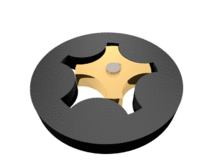
We began working on an uprated oil pump gear last year but put the project on hold as other developments took priority. We have begun working on it again this past Spring. This entry is an update on an effort that is not yet complete. As one of my old Ph.D colleagues from 3M Automotive used to say, "R&D ain't easy"!
The factory oil pump gear is a known weak link in the 2ZZGE engine in cars that see track use. We believe that a combination of high rpm (7k+) coupled with oil starvation (we know how to
fix this) creates a hostile environment for these stock gears. Sintered metal parts start out as powder. This powdered metal is compressed in a shape, heated in a controlled environment and then machined to create the final part shape. This is a cost effective method to produce parts that require tight tolerance. The oil pump gear is considered a gerotor (
see Wikipedia) type. As the inner and outer gears interact with each other, oil keeps them from grinding on each other. If the oil is starved from this system the gears will destroy each other causing all loss of oil pressure and bigger problems for your engine. If the gears are made from a brittle material they will be even more vulnerable.
We started working on a solution last year that we believed would be an effective replacement. We had it made from billet 4340 steel, REM finished and precision ground. We tested them on track and data logged our results. We blogged about it:
HERE. We thought we had a good product until we removed it from our engine to inspect it. The gear teeth had deformed. Clearly it was not ready for prime time so we went back to the drawing board.
Our supplier is a well recognized and experienced gear manufacturer. They scratched their heads for some time as well and delivered a couple of new gears. These had some changes that they believed would improve performance.
We installed the first configuration and took our test Elise to our race shop at
Spring Mountain for testing. We put about 290 track miles on the gear and recorded the conditions. Oil pressure looked great and the car ran fine. We removed the gear and found that we had made some improvement but still showed scoring on the teeth that was not acceptable. See picture below.
So the third configuration was installed and we headed back to the track. 250 track miles later we yanked out the gear and inspected it. This time we found the gears were in the best condition so far. In fact they exhibited some wear that you could see but could not feel. It was similar to the wear that we found on a Circuitworx gear that we had. We then looked at the oil pump housing and realized it was scored - but did that happen with the initial gear? Aarghh!!! (A Charlie Brown moment for sure). We bought a new housing and will be testing the gear again soon.
R&D is always a challenge in a small company but we feel this is the difference between simply fabricating a part and engineering a true solution. So back to the proverbial grindstone...we'll keep you posted as we continue our development on this product.


.jpg)








